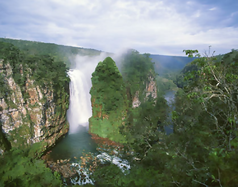Noel Kempff Mercado National Park
| Noel Kempff Mercado National Park | ||
|---|---|---|
| Cataratas Arco Iris | ||
|
|
||
| Location: | Santa Cruz , Bolivia | |
| Surface: | 15,234 km² | |
| Founding: | June 28, 1979 | |
| Giant toucan | ||
The Noel Kempff Mercado National Park is a protected area in the Amazon basin in Bolivia and since 2000, World Heritage of UNESCO . The national park is located in the northeast of the country in the Santa Cruz Department on the border with Brazil and was founded on June 28, 1979.
geography
The national park has an area of 15.234 km² and consists of part of the Huanchaca high plateau ( 750 m ) and the surrounding lowlands ( 200 m ). Most of the park is very rich in water and criss-crossed by many rivers with waterfalls , lagoons and floodplains. The largest lagoons are Bella Vista with 19,600 hectares and Chaplín with 12,500 hectares. The Río Iténez forms the border with Brazil. It connects to the Amazon through several tributaries .
Flora and fauna
The diverse vegetation ranges from tropical rainforests to dry forests and savannahs . Due to the high diversity of habitats in a small area, the park is unusually rich in species, in addition to the 4,000 plant and numerous insect species , 139 mammal , 621 bird , 75 reptile , 62 amphibian and 250 fish species are known.
Plants common in the park include American mahogany , Spanish cedar , Amburana cearensis , rubber tree , cabbage palm , maripa palm ( Maximiliana maripa ), Socratea exorrhiza , buriti palm and various types of orchid .
Among the mammals in the park (including 33 endangered species) are to be found, inter alia, Jaguar , Puma , tapir , peccary , silvery marmoset , giant armadillo , Graumazama , capybara , bush dog , maned wolf , Pampas deer , giant otters and Bolivian Amazon river dolphin .
The reptiles include black caiman , anaconda , arrows turtle ( Podocnemis expansa ), rattlesnakes and iguanas .
Among the most common bird species in the park include Hyacinth Macaw , Red-fronted Macaw , toucans , hawks , Spix's Guan , Turdus haplochrous , southern screamer , Schwarzmantelpfäffchen ( Sporophila nigrorufa ), harpy and Nandu .
More facts
Due to its remote location, the park is difficult to reach and not very well developed for tourists. A permit is required to visit, which is available in Santa Cruz and San Ignacio . You can take the bus to San Ignacio, from there you can take a rental vehicle to the park. The entrance to the national park is at Piso Firme on the banks of the Río Paraguá . From there you can also take a rented boat through the park. There are two small visitor centers: Flor de Oro in the north and Los Fierros in the south of the park. The most visited places include two uninterrupted waterfalls, the 88 meter high Catarata Arco Iris and the 80 meter high Catarata El Encanto , as well as the 45 meter high Catarata Ahlfeld .
The park was initially called Huanchaca National Park and was renamed in 1988 in honor of the biologist Professor Noel Kempff Mercado , who had done a lot for the creation of the park and who was murdered by drug smugglers on a research mission in the park in 1986.
The report of the Rio Verde intermediate expedition to the extraordinary area of today's park in 1910 inspired the writer Sir Arthur Conan Doyle to write his novel " The Forgotten World ".
Web links
- Entry on the UNESCO World Heritage Center website ( English and French ).
- PARQUE NACIONAL NOEL KEMPFF MERCADO (Spanish)
- A Guide To Noel Kempff Mercado National Park (English)
swell
- Parque Nacional Noel Kempff Mercado biobol.org , December 22, 2017, accessed January 2, 2019. (Spanish)
- Parque Nacional Noel Kempff Mercado visitbolivia.org , accessed January 3, 2019 (Spanish)
- Parque Nacional Noel Kempff Mercado santacruz.gob.bo , accessed January 3, 2019. (Spanish)



